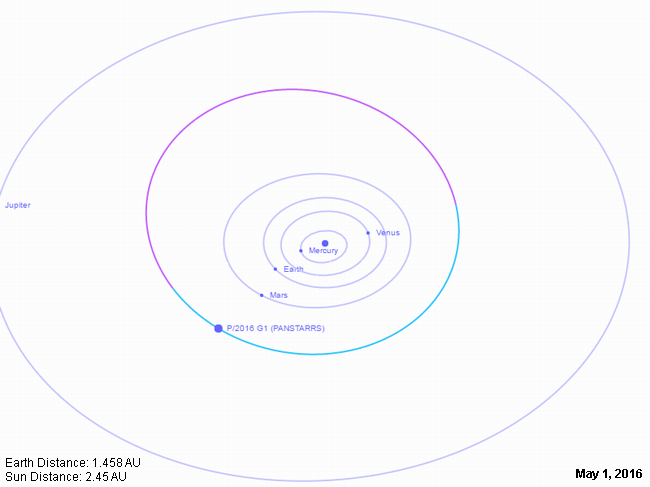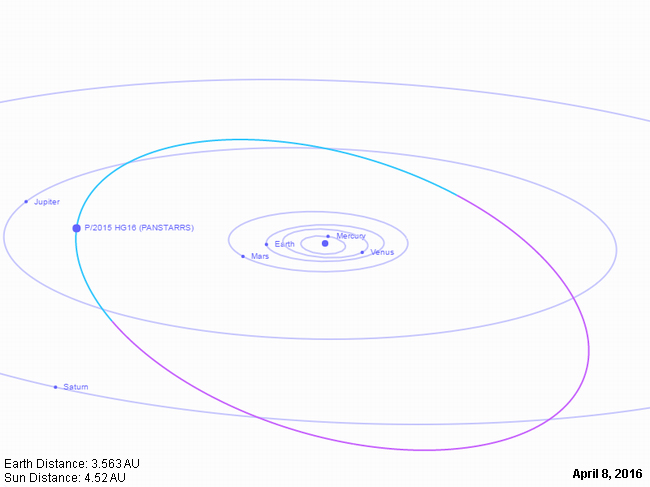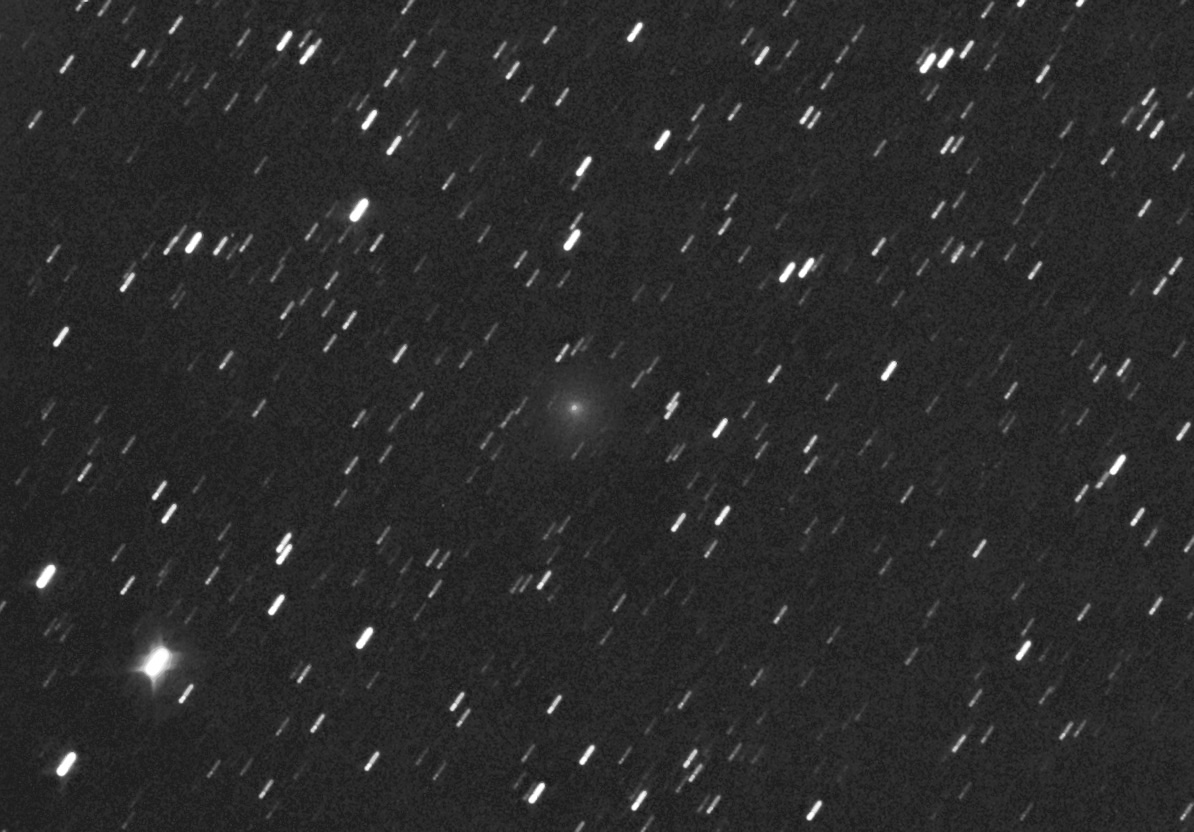Comet discovered in April 2016, C/2015WZ outburst?
Comets discovered in April 2016
P/2016 G1 PANSTARRS
R. Weryk and R. J. Wainscoat report the discovery of a comet on images taken on Apr. 1 UT with the 1.8-m Pan-STARRS1 telescope at Haleakala (CBET4269).
After the object was posted on the Minor Planet Center's PCCP webpage, other CCD astrometrists as K.Sarneczky and H. Sato elsewhere also commented on its cometary appearance.
Images taken by R. A. Kowalski with the Mount Lemmon 1.5-m reflector on Apr. 3.4 show an elliptical coma of mag 18.6 with a major-axis diameter of approximately 14" and a short, thin tail 15" long in p.a. 285 deg. G. V. Williams identified incidental astrometry of the comet from Mt. Lemmon on Mar. 12.5 UT, in which the apparently asteroidal object was measured to have magnitude 18.9-19.2. The available astrometry (spanning Mar. 12-Apr. 4), the following elliptical orbital elements, and an ephemeris appear on MPEC 2016-G72:
T = 2017 Jan. 26.5727
Peri.=111.1342
Node=204.0352
Incl.=10.9455
e = 0.206822
q = 2.046751 AU
a = 2.580444 AU
n =0.2377729
P = 4.15 years

P/2015 HG16 PANSTARRS
R. Weryk and R. J. Wainscoat reported the discovery of a comet on images taken on 2016 Apr. 4 UT with the 1.8-m Pan-STARRS1 telescope at Haleakala (CBET4270); the comet's images appeared slightly larger than those of nearby stars, and there is evidence of a tail extending for approximately 10" towards position angle approximately 310 degrees. Weryk subsequently identified an object seen in faint detections from three w-band Pan-STARRS1 exposures taken on 2016 Feb. 11.
G. V. Williams, Minor Planet Center, noted that the 2016 April 3 observations appeared to belong to a supposedly asteroidal object found a year ago by Pan-STARRS1 on 2015 Apr. 20, 21, and 24 (and then given the minor-planet designation 2015 HG_16 on MPS 603395 and 603396).
Weryk had already identified earlier Pan-STARRS1 observations from 2015 Mar. 24 and Apr. 9 (which are also tabulated below) when Williams made his link between the 2015 and 2016 observations. The following elliptical orbital elements by Williams and an ephemeris appear on MPEC 2016-G114:
T = 2014 June 28.97674
Peri.=48.15343
Node=59.52587
Incl.=18.86851
e = 0.3462278
q = 3.1317834 AU
a = 4.7903284 AU
n =0.0940061
P =10.48 years

C/2015 WZ PANSTARRS
An apparently asteroidal object that was discovered last year with the 1.8-m Pan-STARRS1 telescope at Haleakala (discovery date being 2015 Nov. 17, but with numerous other Pan-STARRS1 images also obtained around that time, as tabulated below), and assigned the minor-planet designation 2015 WZ when announced on MPEC 2015-W30, has been found to show cometary appearance by A. Novichonok, Russia (CBET 4273).
Novichonok writes that he has measured three unfiltered 90-s images of 2015 WZ obtained by G. Borisov with the 0.5-m f/2 telescope of MARGO Observatory near Nauchnij, Crimea, on 2016 Apr. 17.05 UT; the object shows a diffuse, moderately condensed coma of diameter about 1'.9 with a possible tail 1'.4 long in p.a. 282 deg; the total red magnitude of the comet was 13.0 as measured in a circular aperture of size 2'.02. The available astrometry, the following nearly-parabolic orbital elements by G. V. Williams, and an ephemeris appear on MPEC 2016-H29.
T =2016 Apr. 15.79862
Peri.=66.71011
Node = 40.04558
Incl. = 134.13477
e = 0.9929157
q =1.3766422 AU
As confirmed by Michael Jager’s image below, an outburst occurs in late April and the comet could be visible with medium size telescope or digital camera lens.

©M.Jager
No results found.
